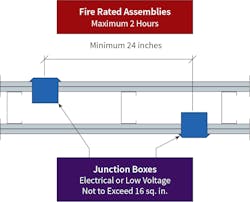In electrical work, installation requirements can be found in a variety of codes such as building, fire/life safety, or energy. Although trade specialists (such as electricians) may be experts in their respective fields, they are often unaware of requirements outlined in codes or standards outside their key discipline. This leads to improper installations and failed inspections.
An example of this is the placement of electrical equipment in fire-rated assemblies. As an inspector, I frequently run across improperly placed junction boxes (JBs) in firewalls (e.g., fire-rated assemblies). This article will highlight the improper installation of JBs and shed light on the fire blocking problems I find in the field.
Although the proper placement of JBs and fire blocking can be a problem in residential construction, this article will mainly focus on commercial installations.
Codes and standards for JB installations
When placing a JB in a fire-rated assembly (e.g., wall, ceiling, membrane, etc.), you must follow specific guidelines established by the International Building Code (IBC) and/or the International Residential Code (IRC) and the National Electrical Code (NEC). The good news is the applicable sections in the IBC and IRC are nearly identical in regard to JBs in firewalls. This makes sense as both of these codes are published by the International Code Council (ICC).
Most electricians are well versed in the requirements outlined in the NEC. Many own a copy of it. But when it comes to the IBC or IRC, this is not the case. I don’t know a single electrician who owns a copy of any ICC code book. This is unfortunate as these codes refer to each other fairly often, as you will see in the code references below.
NEC requirements
The NEC only briefly touches on the subject of reducing fire spread and installing JBs. See Sec. 300.21 [Spread of Fire and Products of Combustion] in the 2020 NEC. One of those references is a short Informational Note, which most electricians don’t read.
“NEC 300.21 Spread of Fire or Products of Combustion. Electrical installations in hollow spaces, vertical shafts, and ventilation or air-handling ducts shall be made so that the possible spread of fire or products of combustion will not be substantially increased. Openings around electrical penetrations into or through fire-resistant-rated walls, partitions, floors, or ceilings shall be fire stopped using approved methods to maintain the fire-resistant rating.
“Informational Note: Directories of electrical construction materials published by qualified testing laboratories contain many listing installation restrictions necessary to maintain the fire-resistive rating of assemblies where penetrations or openings are made. Building codes also contain restrictions on membrane penetrations on opposite sides of a fire-resistance-rated wall assembly. An example is the 24-inch minimum horizontal separation that usually applies between boxes installed on opposite sides of the wall. Assistance in complying with 300.21 can be found in building codes, fire-resistant directories, and product listings.”
IBC and IRC requirements
The IBC and IRC codes are much more detailed on this topic. The IRC requirements can be found in Sec. R302.4. They will not be listed here. The IBC requirements (Sec. 714.4) are presented here for your review:
“714.4.2 Membrane Penetrations. Membrane penetrations shall comply with Sec. 714.4.1. Where walls are required to have a fire-resistance rating, recessed fixtures shall be installed so that the required fire-resistance rating will not be reduced.
“Exceptions:
“1. Membrane penetrations of not more than 2-hour fire-resistance-rated walls and partitions by steel electrical boxes that do not exceed 16 sq. in. (0.0103 m2) in area, provided that the aggregate area of the openings through the membrane does not exceed 100 sq. in. (0.0645 m2) in any 100 sq. ft (9.29 m2) of wall area. The annular space between the wall membrane and the box shall not exceed 1/8 in. (3.1 mm). Such boxes on opposite sides of the wall shall be separated by one of the following:
“1.1 By a horizontal distance of not less than 24 in. (610 mm) where the wall or partition is constructed with individual noncommunicating stud cavities.
“1.2 By a horizontal distance of not less than the depth of the wall cavity where the wall cavity is filled with cellulose loose-fill, rock wool, or slag mineral wool insulation.
“1.3 By solid fire blocking in accordance with Sec. 718.2.1.
“1.4 By protecting both boxes with listed putty pads.
“1.5 By other listed materials and methods.”
The Figure shows an acceptable method of placing JBs in a fire-rated assembly following the stated codes. JBs in the same stud cell must meet the applicable requirements of the IBC (Sec. 714.4.2, Exception 1.1).
Synopsis
What all of this boils down to is that electricians need to understand there are other codes to follow, not just the NEC. They must recognize and follow all applicable building codes and standards that relate to the work they do in the field.
Joseph Alexander, C.B.O., C.F.M, M.C.P., is the chief building official for the City of Suwanee, Ga. He can be reached at [email protected].




